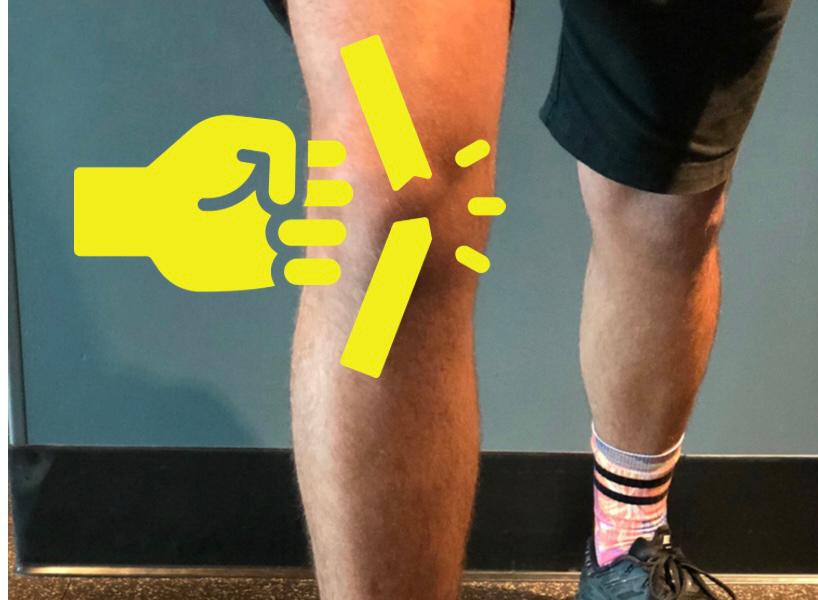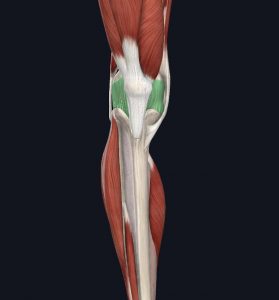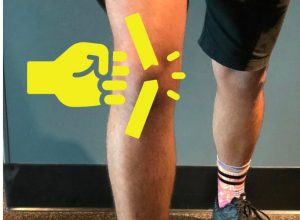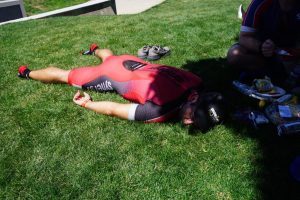
Recent MCL tear holding you back from your favorite activities? With the right guidance, you can successfully rehabilitate your knee and return to surfing, football, or whatever fuels your soul.
First thing’s first. Successful recovery requires your full commitment. Set your expectations and realistic goals by fully understanding MCL tear recovery time and the rehabilitation ahead.
On Oahu and (k)need help? JACO Rehab can guide you in the right direction with 1-on-1 physical therapy sessions for over 50 minutes. Call us to schedule.
About the Medial Collateral Ligament (MCL)
The medial collateral ligament (MCL) is the major stabilizing structure on the medial side of your knee, or the inner aspect of your knee. It’s a thick structure that accounts for a big portion of the joint capsule.
The MCL even serves as several attachment points for other ligaments and muscles of the thigh.
- The MCL hides in the joint capsule (highlighted), specifically the medial aspect (highlighted area on the right side of the kneecap in this picture)
Images courtesy of Complete Anatomy
The MCL protects the knee from excessive inward motions like excessive internal rotation or dynamic valgus.
It’s common to see this injury accompanied by other injuries. ACL tears and meniscus tears are often seen with MCL tears because they are all injured in similar ways.
- Direction of force during an MCL tear
3 Ways MCL Tears Can Happen
MCL injuries always involve excessive inward motion of the knee, but this can happen in different ways. Here are 3 ways MCLs are usually injured.
Non-contact injury
Non-contact MCL tears often occur as a result of poor landing mechanics, similar to an ACL tear. The knee will rotate or cave inward, stressing the MCL to the point of tear or rupture.
The best way to prevent a non-contact tear is by strengthening protective musculature and training proper movement patterns in your sport. This includes landing mechanics and balance.
It’s also important to make sure the playing surface is good quality. Fields with uneven grass patches or holes could cause injuries like an MCL tear.
Direct trauma
A direct blow from the outside of the knee can also cause an MCL tear. This is common during soccer, football, and rugby tackles.
It’s difficult to prevent this. A traumatic MCL tear is dependent on opponent behavior. You could decrease your risk by improving your reaction time and advocating for safe sport practices.
Repetitive stress
Some sports like surfing require awkward positions that could apply repetitive stress of the MCL. Without adequate mobility in other joints, the MCL can take a beating.
Preventing repetitive stress to the MCL is similar to preventing non-contact injury. By strengthening protective musculature, you can better control these awkward movements and prevent excessive stress on the MCL.
It’s also important to check the mobility of the joints above and below the knee. If the hips aren’t moving well, your knee will have to take over… but the knee isn’t built to be as flexible as a hip! You don’t want to place more stress on the knee than it can handle. Make sure every joint is coordinating with neighboring joints.
Will I Need Surgery?
Because the MCL is so thick and complex, it’s possible to partially tear it and rehabilitate without surgery.
Small sprains and tears can heal conservatively under the care of a physical therapist. Larger tears usually require surgery. (2)
A doctor’s decision between conservative care and surgery is determined by:
- the size of the tear
- joint stability
- functional deficits
MCL Tear Recovery Time: Non-Surgical vs Surgical
Alright, here’s the lo-down.
Recovery time looks different for everyone. Two soccer players with the exact same MCL tear can have completely different recovery experiences.
Your progression through rehabilitation can vary depending on:
- Prior activity level and pre-existing movement patterns
- Pain and swelling levels
- Adherence to your home exercise program and activity modifications
- Consistency of sessions
However, there are general trends to MCL tear recovery.
Non-Surgical Recovery & Physical Therapy
If you’re recovering conservatively, your tear is relatively small or its location on the MCL does not impact your stability. That’s good news, but you still have work to do before returning to advanced activities like running or jumping.
Research has studied recovery time for MCL injuries, but mostly in athletics. Athletes tend to take an average of 3-4 weeks to return to their sport if their injury only required rehabilitation. (1, 3)
Athletes only represent a portion of individuals receiving treatment for MCL injuries. Expect no less than 3-4 weeks recovery, and don’t be surprised if it takes a little longer. This is especially true if you need some refreshers on foundational movement patterns, or if your physical therapist detects some major risk factors that may have predisposed you to the injury in the first place.
Speaking of physical therapy…
Your first few therapy sessions will work on regaining range of motion and muscle activation to combat stiffness and instability. You’ll progress slowly to make sure swelling and pain is under control.
Weeks 2-4+ aim to carefully progress muscle activation into functional strengthening and balance training while monitoring pain levels. Each session progresses you closer to your specific goals, whether that’s normalized walking, running, return to sport, or all the above.
Remember that your timeline could be longer if your injury was more significant.
Surgical Recovery & Physical Therapy
If you’re recovering after surgery to address your MCL injury, the initial part of your recovery will look slightly different.
The main priority after surgery is to protect the repair/reconstruction. Your progress may be slow at first due to post-surgical pain and swelling. You will be using crutches to offload the surgical leg. You may also have a hinged brace which will be locked in a certain position depending on your surgeon’s requirement.
Swelling and pain levels will determine how quickly you can discharge your brace. You’ll need it for about 6 weeks.
However, your rehabilitation starts way before that 6-week mark!
You’ll likely see physical therapy days after your surgery unless otherwise indicated by your surgeon. During your first visit, your physical therapist will review your surgical protocols to make sure you stay safe while you heal. You’ll review how to use your crutches and how you can gently begin moving and strengthening your leg.
Then you get into the good stuff!
We would be lying if we didn’t admit that the following visits aren’t hard work. You’ll be working on regaining your mobility, strength, and proper walking mechanics within your surgical protocols.
Your rehab progressions place a major emphasis on developing good movement habits to preserve the MCL. If you have some bad habits to reprogram, you may need to hover in this phase of rehab. Developing sound foundational strength and movement patterns are key to preventing re-injury.
Toward the later half of therapy, you’ll begin a running program and sport-specific strengthening.
Rehabilitation after an MCL repair or reconstruction can take several months, especially if you’re returning to sport.
It’s okay to be bummed out! But it’s important to focus on the road ahead. JACO Rehab will be with you every step of the way.
- It’s okay to be bummed out!
How Do I Know If I’m Ready to Return to Sport?
It always feels uneasy going back into sport after an injury. It’s common to feel fear or a lack of confidence. But, with the right guidance, you can make that transition much smoother.
If your goal is return to sport, you’ll undergo sport-specific testing to see if you’re ready. These tests challenge your:
- Stability
- Landing mechanics
- Agility
To return to sport, the injured leg should score similarly to the non-injured leg. Testing shouldn’t be painful and should feel stable.
If you clear your testing, you can ease back into your sport. Don’t rush into competition, though.
You can ease into sport by following this progression:
- Light drills on your own and with a teammate
- Light drills during practice
- Heavier drills during practice (ex. keep-balls, sprint drills)
- In-practice scrimmages
- Competitive play with modified play time (ex. sub in for 15 minutes before halftime)
Keep tabs on how you feel. If scrimmages cause discomfort later that night, you may want to focus on strengthening exercises provided by your therapist and stick to drills during practice until you’re ready to try again.
At JACO, you can always email your therapist after discharge if you have questions about your recovery.
You Got This!
MCL tear recovery time varies greatly. There is no one-size-fits-all approach to rehabilitating an MCL injury.
Get the right guidance and work towards your goals! Contact JACO Rehab to make sure you’re on the right track.
Cited References
- Lavoie-Gagne OZ, Retzky J, Diaz CC, et al. Return-to-Play Times and Player Performance After Medial Collateral Ligament Injury in Elite-Level European Soccer Players. Orthopaedic Journal of Sports Medicine. September 2021. doi:10.1177/23259671211033904
- Logan CA, O’Brien LT, LaPrade RF. POST OPERATIVE REHABILITATION OF GRADE III MEDIAL COLLATERAL LIGAMENT INJURIES: EVIDENCE BASED REHABILITATION AND RETURN TO PLAY. Int J Sports Phys Ther. 2016 Dec;11(7):1177-1190. PMID: 27999730; PMCID: PMC5159640.
- Lundblad M, Waldén M, Magnusson H, Karlsson J, Ekstrand J. The UEFA injury study: 11-year data concerning 346 MCL injuries and time to return to play. Br J Sports Med. 2013;47(12):759-762.



